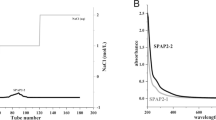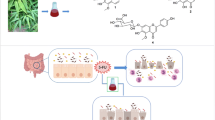Abstract
Fungi of the Pleurotus genus present a great industrial interest due to their possibility of producing pharmacological compounds, pigments, aromas, organic acids, polysaccharides, enzymes, vitamins, amino acids, etc. Among the therapeutic products, we can highlight those with antineoplasic activity, attributed to the fungi cell wall components. Based on this, the objective of this work was to study the antineoplasic capacity of the polysaccharidic fractions obtained from Pleurotus sajor-caju fruiting bodies. Female Swiss mice were inoculated with the Ehrlich ascitic tumor (5 × 106 cells/animal) in ascitic form. The polysaccharidic fractions were administered intraperitoneally, during a 6-day period. Fractions FI and FII presented a lower volume of ascitic liquid (3.1 and 1.8 mL, respectively) and a higher reduction in the number of neoplasic cells present in the ascitic liquid (86.2% and 85%, respectively), when compared to the positive control (group inoculated with the tumor but without treatment). These fractions were characterized in terms of monosaccharide composition. Glucose was the major component detected, followed by galactose and mannose. The anomeric carbon configuration of the β-glucan was confirmed by the 13C NMR (δ 103.7). Substituted and free C3 and C6 were also detected. Protein bands were confirmed through infrared analysis.





Similar content being viewed by others
References
Abbas, A. K., Lichtman, A. H., & Pober, J. S. (2000). In Cellular and molecular immunology, 4th ed, Chap 17: Immunity to tumors (pp. 384–403). Pennsylvania: Saunders.
Estimativa (2008). Incidência de Câncer no Brasil 2008. Available from: www.inca.gov.br/estimativas/2008. Accessed Feb 2008.
Doroshow, J. H. (2004). In R. E. Pollock, J. H. Doroshow, D. Khayat, A. Nakao & B. O’Sullivan (Eds.), UICC manual of clinical oncology, 8th ed, Chap 10: Principles of medical oncology (pp. 208–219). New Jersey: Wiley.
Okey, A. B., Harper, P. A., Grant, D. M., & Hill, R. P. (1998). In I. F. Tannock & R. P. Hill (Eds.), The basic science of oncology, 3rd ed, Chap 3: Chemical and radiation carcinogenesis (pp. 25–48). New York: Mc Graw Hill.
Lopes, L., Godoy, L. M. F., Oliveira, C. C., Gabardo, J., Schadeck, R. J. G., & Buchi, D. F. (2006). Micron (Oxford, England), 37, 277–287. doi:10.1016/j.micron.2005.08.005.
Piemonte, M. R., & Buchi, D. F. (2002). Journal of Submicroscopic Cytology and Pathology, 34(3), 255–263.
Lull, C., Wichers, H. J., & Savelkoul, H. F. (2005). Mediators of Inflammation, 2, 63–80. doi:10.1155/MI.2005.63.
Zhang, J., Wang, G., Li, H., Zhuang, C., Mizuno, T., Ito, H., et al. (1994). Bioscience, Biotechnology, and Biochemistry, 58(7), 1195–1201.
Ooi, V. E. C., & Liu, F. (2000). Current Medicinal Chemistry, 7, 715–729.
Bobek, P., Galbavy, S., & Ozdin, L. (1998). Oncology Reports, 5(3), 727–730.
Zhuang, C., Mizuno, T., Shimada, A., Ito, H., Suzuki, C., Mayuzumi, Y., et al. (1993). Bioscience, Biotechnology, and Biochemistry, 57(6), 901–906.
Furlan, S. A., Virmond, L. J., Miers, D. A., Bonatti, M., Gern, R. M. M., & Jonas, R. (1997). World Journal of Microbiology & Biotechnology, 13, 689–692. doi:10.1023/A:1018579123385.
Bonatti, M., Karnopp, P., Soares, H. M., & Furlan, S. A. (2004). Food Chemistry, 88, 425–428. doi:10.1016/j.foodchem.2004.01.050.
Pagno, T., Blind, L. Z., Biavatti, M. W., & Kreuger, M. R. O. (2006). Brazilian Journal of Medical and Biological Research, 39(11), 1483–1491.
Zhang, P., & Cheung, P. C. K. (2002). Bioscience, Biotechnology, and Biochemistry, 66(5), 1052–1056. doi:10.1271/bbb.66.1052.
Matsuzaki, P., Akisue, G., Salgado Oloris, S. C., Gorniak, S. L., & Zaidan Dagli, M. L. (2003). Life Sciences, 74(5), 573–579. doi:10.1016/j.lfs.2003.05.010.
Zhang, L., Zhang, M., Zhou, Q., Chen, J., & Zeng, F. (2000). Bioscience, Biotechnology, and Biochemistry, 64(10), 2172–2178. doi:10.1271/bbb.64.2172.
Rorabacher, D. B. (1991). Analytical Chemistry, 63(2), 139–146. doi:10.1021/ac00002a010.
Vinogradov, E., & Wasser, S. P. (2005). Carbohydrate Research, 340, 2821–2825. doi:10.1016/j.carres.2005.09.024.
Bano, Z., Rajarathnam, S., & Shashirekha, M. N. (1998). Critical Reviews in Biotechnology, 18(2 and 3), 91–236.
Zhang, M., Cui, S. W., Cheung, P. C. K., & Wang, Q. (2007). Trends in Food Science & Technology, 18, 4–19. doi:10.1016/j.tifs.2006.07.013.
Gonzaga, M. L. C., Ricardo, N. M. P. S., Heatly, F., & Soares, S. A. (2005). Carbohydrate Polymers, 60(1), 43–49. doi:10.1016/j.carbpol.2004.11.022.
Gutiérrez, A., Prieto, A., & Martínez, A. T. (1996). Carbohydrate Research, 281(1), 143–154. doi:10.1016/0008-6215(95)00342-8.
Sassaki, G. L., Gorin, P. A. J., & Iacomini, M. (2001). FEMS Microbiology Letters, 194, 155–158. doi:10.1111/j.1574-6968.2001.tb09461.x.
Gorin, P. A. J. (1981). Advances in Carbohydrate Chemistry and Biochemistry, 38, 13–104. doi:10.1016/S0065-2318(08)60309-1.
Silverstein, R. M., Webster, F. X., & Kiemle, D. (2005). Spectrometric identification of organic compounds (7th ed.). New York: Wiley.
Sarangi, I., Ghosh, D., Bhutia, S. K., Mallick, S. K., & Maiti, T. K. (2006). International Immunopharmacology, 6(8), 1287–1297. doi:10.1016/j.intimp. 2006.04.002.
Acknowledgments
The team wishes to thank the Research and Support Fund—FAP from UNIVILLE for the financial backing for the project; the Basidiomycete Cultivation Center of the Botanical Institute of São Paulo for donating the fungus strain; and Dr. A. A. Steil and Dr. D. Sato, from the University of Itajaí—UNIVALI for the donation of the tumor strain.
Author information
Authors and Affiliations
Corresponding author
Rights and permissions
About this article
Cite this article
Dalonso, N., Souza, R., Silveira, M.L.L. et al. Characterization and Antineoplasic Effect of Extracts Obtained from Pleurotus sajor-caju Fruiting Bodies. Appl Biochem Biotechnol 160, 2265–2274 (2010). https://doi.org/10.1007/s12010-009-8678-9
Received:
Accepted:
Published:
Issue Date:
DOI: https://doi.org/10.1007/s12010-009-8678-9




